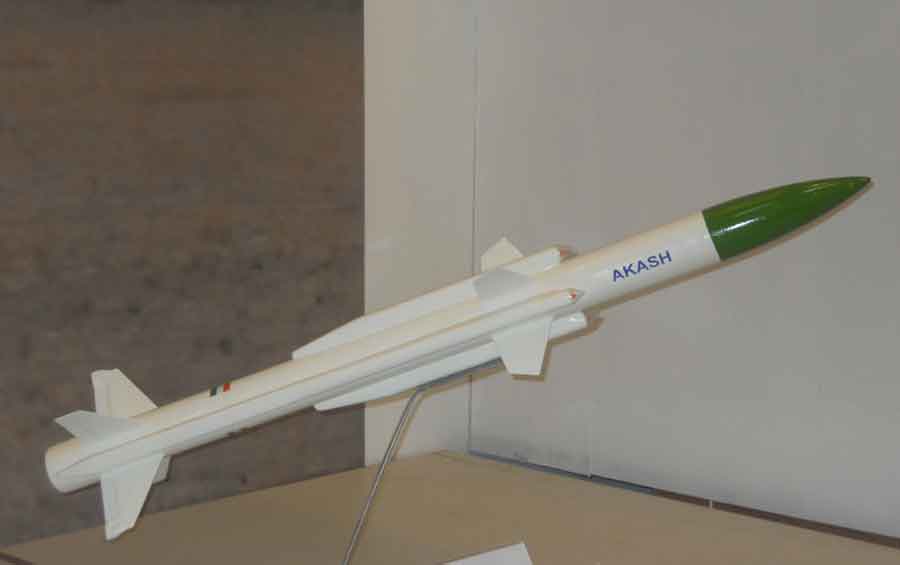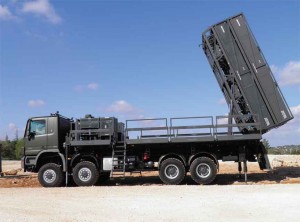The ‘Akash’ has been described as using a missile airframe similar to the Soviet SA-6 with upgraded seeker heads and a completely modern Rajendra fire-control radar similar to that of the Russian S-300. The ramjet-powered missile reportedly flies at Mach 2.5 (the normal speed for a Surface-to-Air Missile) all the way to the end of its range, instead of accelerating and then coasting like rocket-powered SAMs. It uses a conventional warhead with semi-active radar homing guidance and the reported operating range is 25 to 30 km or 18 miles, to a maximum altitude of 18 km or 59,000 feet. The missile is supported by multi-target and multi-function phased array fire control radar called ‘Rajendra’ that has a reported range of about 60 km or 36 miles. Each Akash flight consists of a Rajendra fire control radar, four launchers, and a Battery Command Post, all linked to a group command post with a 170 km Rohini (3D CAR variant) S-band search radar along with maintenance and replenishment vehicles. India also has an ongoing Anti-Ballistic Missile (ABM) programme and one unit is ready for operationalisation.
India also has an ongoing Anti-Ballistic Missile (ABM) programme and one unit is ready for operationalisation…
Spyder AD System
As per plans made public in 2006, India will acquire 18 Spyder SAM systems from Israel. However, the acquisition project was put on hold due to allegations of corruption over the Israeli Barak missiles deal for the Indian Navy signed four years ago. But as none of the three services in India has adequate missile defence protection, for several years now the government has been under pressure to remedy the situation.
The Spyder deal was signed on September 01 with Rafael and Israel Aircraft Industries (IAI). There was no formal announcement but sources indicated that the delivery schedule was expected to be within two to three years. The Spyder system is a static Low Level, Quick Reaction Missile (LLQRM) to neutralise hostile targets up to 15 km away and at heights between 20 to 9,000 metres. The IAF will also acquire the indigenous Akash SAM system which has an effective range of 25 km as part of a layered approach to defend its assets. Both the Spyder and Akash are all-weather missiles with 360 degrees coverage, autonomous management system and advanced ECCM capability. It can be launched within five seconds and once the commander has pressed the button, the process to seek and engage a hostile aircraft or missile is automated.
The Spyder consists of the Python-5 IR guided and Derby RF guided Beyond Visual Range (BVR) missiles, both with Lock-on Before Launch (LOBL) and Lock-on After Launch (LOAL) modes, for faster response time and improved engagement flexibility. Besides aircraft and UAVs, they can also neutralise low-level cruise missiles. Each Spyder unit has four missiles in ready-to-fire launch containers for multi-target engagement and up to six of these units can be deployed around one asset and under one commander. In mid 2005, the IAF had sent a Request for Proposals (RFP) to Russia, France, South Africa, Switzerland, Israel, Poland and the United Kingdom. The Spyder was finally chosen after field trials of all the systems offered by the vendors bidding in response to the RFP.
The IAF will also acquire the indigenous Akash SAM system which has an effective range of 25 km…
It may be noted that the political leadership in 1990 had put a virtual block on all military purchase programmes and there was no periodic replacement or upgrade of equipment for several years. The Indian Army, the Indian Navy and the IAF had been conserving the Soviet vintage weapons till 1999, when Pakistani occupation of territories on the Indian side of the border led to a war and the routine replacement and acquisition process restarted. The three services have been pointing out that their major assets, from airbases and ships to command headquarters, would be nearly “naked’ if there was an aggression and that a missile defence cover was required without any more delay. All the three services are now in various stages of acquiring air defence missiles with different ranges and capabilities, but it would be a few years for them to acquire an effective air defence capability.
Conclusion
GBADS will play a critical role in the next war. India has lagged behind in modernisation of its AD resources. The DRDO has not delivered and every ‘buy’ option is invariably marred by allegations of corruption which brings the procurement process to a grinding halt. Pakistan receives hardware from China which has a flourishing military-industrial complex churning out world-class GBADS. India will have to reckon with her own territorial problems with China and Pakistan in the years to come. Without a robust GBADS the Indian armed forces will certainly be at a disadvantage. The Defence Research and Development Organisation will have to get its act together and produce what it promises or else India will have no option but to buy from those willing to sell.
References
- Wikipedia open sources.
- Surviving the Modern Integrated Air Defence by D Carlo Kopp.
- Archie to SAM by Kenneth P Werrel.







Very informational and positively written paper.
Thank you Air Marshal Menon.